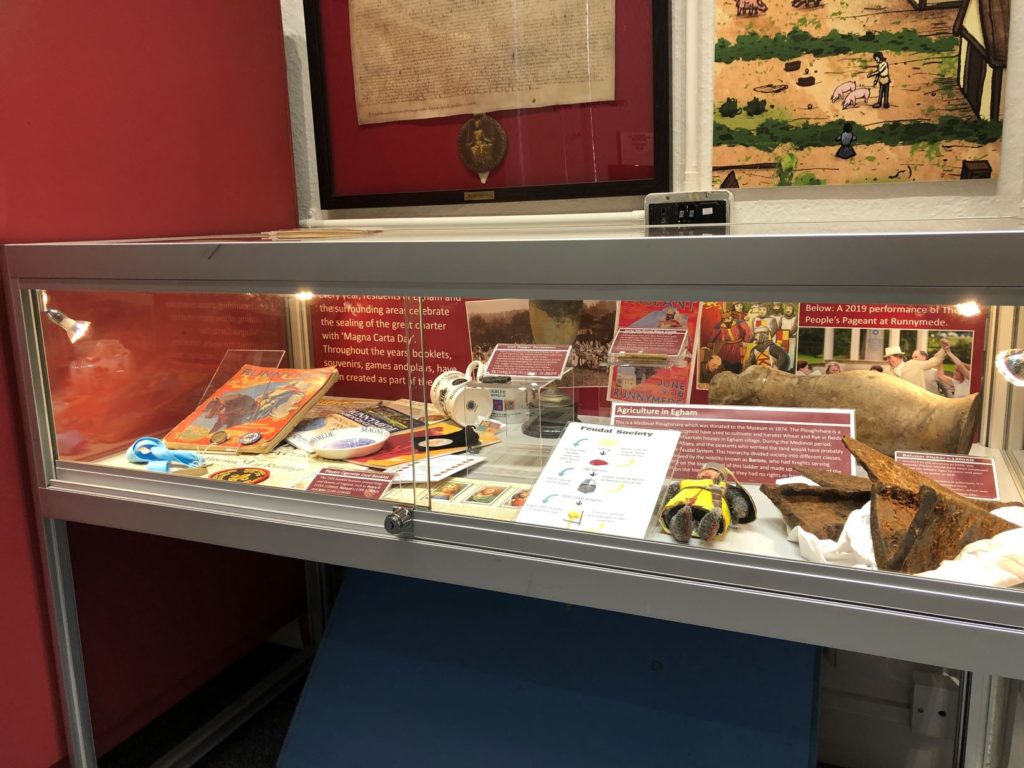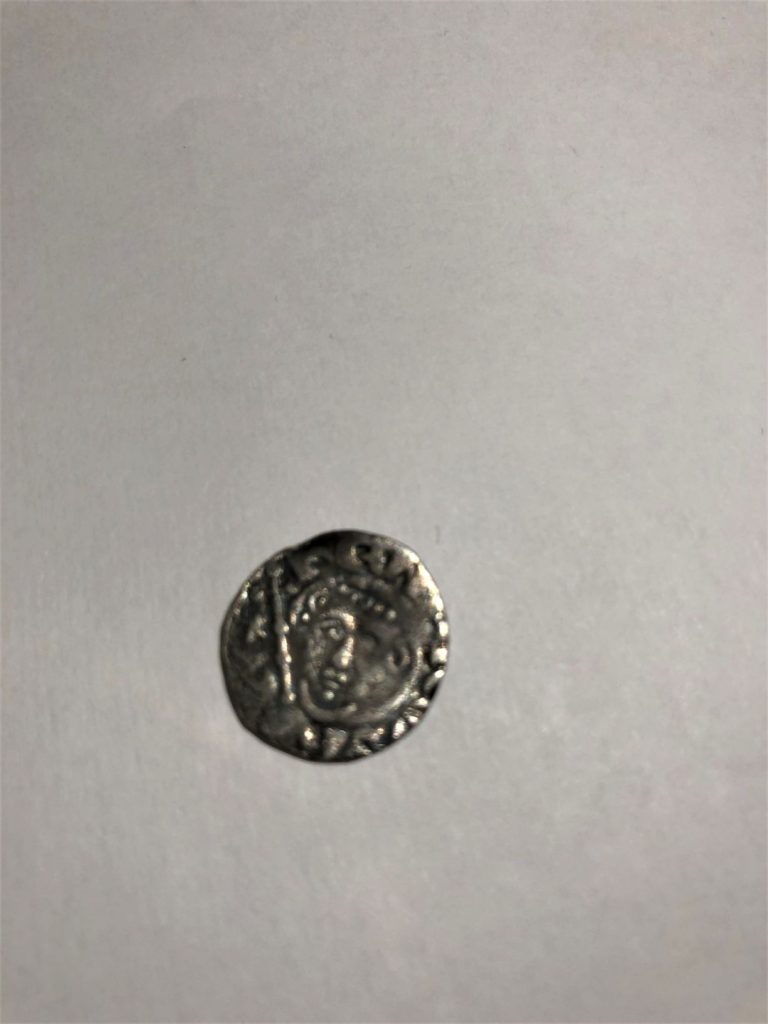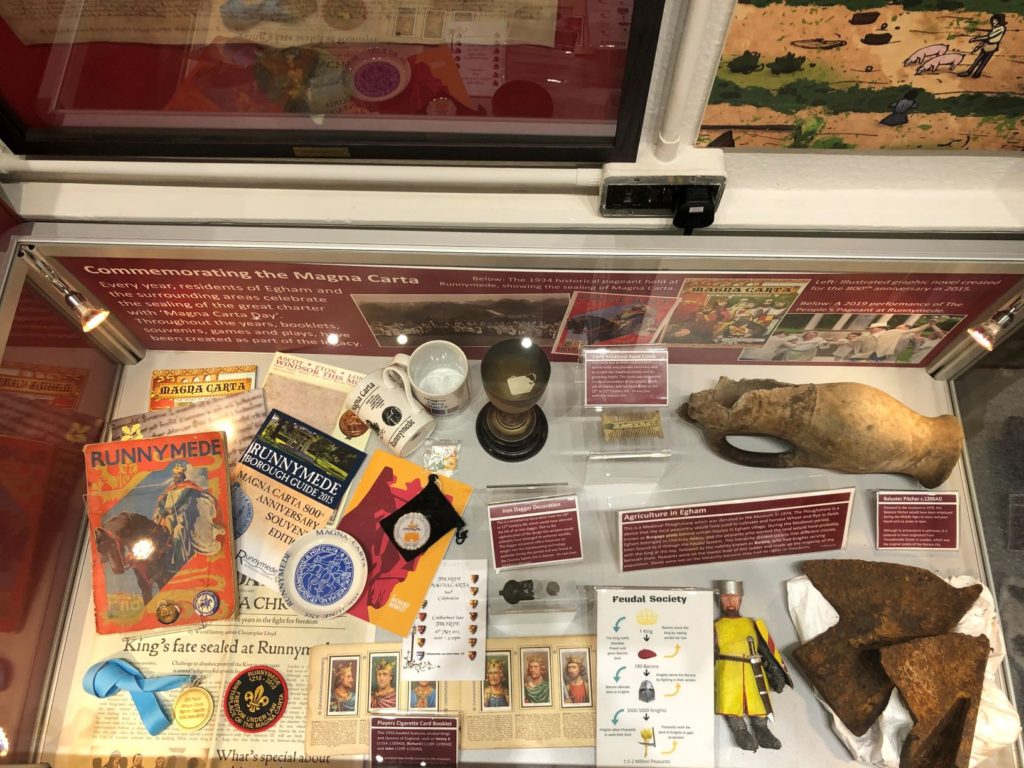Behind the Glass: Medieval Egham
The Egham Museum tells the story of Egham, Egham Hythe, Englefield Green, Thorpe and Virginia Water from pre-history to the present day.
We’ve divided these stories into six sections.
Pre-Historic Egham
Medieval Egham
Early Modern Egham
Victorian Egham
Egham at War
Post-Way Egham
Our Behind the Glass series gives you a tour of the items in the cases, you can see them all together in our Museum Tour video below.
Medieval Egham

Medieval Egham
In 1086, William I of England, better known as William the Conqueror, carried out a survey to record the land ownership in England, known and the Domesday book. In the survey, Egham is recorded to have 57 households, which was considered very large at the time.
Early Medieval Bone Comb (on loan from Spelthorne Museum CS81)
This comb was probably crafted from animal bone and provides historians with an insight into medieval society and its grooming habits. The comb was discovered in a local excavation at the County Sports site in Staines and has been dated to the 10th or 11th Century AD.
Baluster Pitcher (CER273)
Donated to the museum in 1978, this Baluster Pitcher would have been used during the Middle Ages to store and pour liquid such as water or beer. Although its provenance is unknown, it is believed to have originated from Threadneedle Street in London in around 1200AD, which was the original centre of the Roman city.
Medieval Ploughshare (MC98)
This Medieval Ploughshare was donated to the Museum in 1974.
The Ploughshare is a device that the local peasantry would have used to cultivate and harvest Wheat and Rye in fields known as Burgage plots behind certain houses in Egham village. During the Medieval period, Egham belonged to Chertsey Abbey, and the peasants who worked the land would have probably been bound to it through the Feudal system. This hierarchy divided society into different classes, with the King at the top, followed by the nobility known as Barons, who had knights serving beneath them. Peasants were on the lowest level of this ladder and made up the majority of the population. Slaves were not on the hierarchy because they had no rights or freedoms.
Iron Dagger decoration (on loan from Spelthorne)
This is an ornamental decoration from the 10th or 11th century AD, which would have adorned the hilt of an iron dagger. Due to the sophistication of the design, this weapon would probably have belonged to someone wealthy. The dagger ornament offers historians an insight into the metalworking technology available during this period and was found at the Country Sports site in Staines.
King John coin
King John was the King of England between 1166 and his death in 1216. He is best known for granting the Magna Carta in 1215.
This coin, known as a short-cross silver penny, was used throughout the reigns of Henry II, Richard I, John and Henry III. There was only one coin during this time, which could be cut in half or quarters for smaller denominations.

King John Coin 
Iron Dagger decoration
(on loan from Spelthorne)
Magna Carta
The Magna Carta, meaning the ‘Great Charter’, set out a series of laws for everyone to follow, even the King, and was sealed at Runnymede on 15 June 1215. Of the 63 clauses, 3 are still in use. These include a defence of the rights of the English Church, the liberties and customs of London, and the right to a fair trial.
The Magna Carta was such a significant event that it has been commemorated on the Runnymede site (now owned and managed by the National Trust) and in the surrounding area ever since.
Our case includes some souvenirs and other items from these commemorative events including our own project which marked 800 years since the sealing of the Magna Carta. More information about this project can be found at magnacarta.eghammuseum.org.
The Magna Carta Challenge Cup (MC1089) from the Egham Band in 1925.
Cigarette Cards (on loan from Cllr M Kusneratis)
This 1935 booklet features several Kings and Queens of England, such as Henry II (1154-1189AD), Richard I (1189-1199AD) and John (1199-1216AD)
Programme and Song Book (DOC5391) from the Thorpe Magna Carta 800 Celebrations on 16 May 2015
Medallions (MC1273 and MC1290) from the Egham Magna Carta Regatta on 28 Jue 2015.
China Magna Carta ashtray (CER426) ‘Magna Carta 15th June 1215 Runnymede’
Book: Magna Carta on Runnymede and The Charter of the Forest by Richard Rowley
Sunday Times “Special Edition” for Magna Carta 2015 (DOC5402/C)
Fine bone china black and white decorated mug (CER419) ‘Magna Carta Runnymede 1215-2000’.
Mug showing medieval panels and legacy panels (CER458) and Lapel Pin (MC1277) depicting sections of the Magna Carta Quilts
The Magna Carta Quilts were made for the 800th anniversary of Magna Carta 1215-2015: 4 medieval panels, 4 legacy panels. The medieval panels depict the events leading up to the sealing of Magna Carta on Runnymede 1215. The legacy panels depict images of people who have been key figures in the field of Human Rights across the world.
Runnymede District Scouts, Magna Carta Badge (MC1317) which was commissioned for 2015 Magna Carta 800 anniversary. It reads “Runnymede 1215-2015 Freedom under law. Birthplace of the Magna Carta”
Egham and District Chrysanthemum Society Magna Carta Challenge Cup (MC1300A)
Runnymede Pageant performers badge (MC1308B) from the Owens Family, Englefield Green
Runnymede Pageant Programme (B869) fromJune 1934
Souvenir Guide Book Runnymede Borough Council 2015
Booklet Magna Carta Road to Runnymede
Booklet Magna Carta 800 years May/June 2015 Ascot Eton Windsor London
Baron figurine donated by former volunteer on Magna Carta Day



